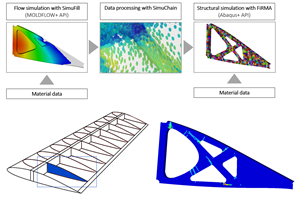Gardner Business Index at 55.3 in February
Business expectations soar as the US composites industry posts growth in every geographical area.
With a reading of 55.3, the Gardner Business Index (GBI) in February 2017 showed that the composites industry in the US had grown at an accelerating rate for a third straight month. In fact, the industry grew in February at its fastest rate since May 2014. And in the second half of 2016, the Index showed that the industry had performed its best since the first half of 2015. Given other economic trends, this should be a positive sign for the US composites industry for the remainder of 2017.
New orders grew at an accelerating rate in February for a third month in a row as this subindex reached its highest level since May 2014. The production subindex also continued to grow but at a slightly slower rate. The backlog subindex increased for the first time in a year and only the third time since May 2014. But this subindex has trended up since July 2015, which indicated increasing capacity utilization in 2017. Employment increased for the seventh consecutive month. Exports decreased after two months of growth. Supplier deliveries lengthened significantly in both January and February.
Since April 2016, material prices had increased at a consistently strong rate — this subindex remained just below 60 in most months all the way through the end of 2016. But, in January and February of this year, material prices increased at an even faster rate. The rate of increase in February, in fact, was at its fastest since the GBI survey was first recorded in December 2011. Prices received increased at an accelerating rate for a fourth month in a row. The subindex had trended up since January 2016. Future business expectations remained strong, with the subindex riding above 80 for a third straight month.
In terms of markets served, two of the US composites industry’s most watched sectors posted notable growth in February. The aerospace subindex grew for the sixth time in eight months. By month’s end, the aerospace index had been above 60 in two of the previous three months. The automotive subindex also grew, and did so for a third month in a row, although the growth rate was minimal in both January and February.
Regionally, the US composites industry posted growth across all geographical divisions. The North Central-East was the fastest growing region for the fourth time in five months, although in February, the North Central-West expanded almost as fast. The Southeast, West, South Central and Northeast all recorded solid growth in February.
As February closed out, US composites manufacturing facilities with more than 250 employees were showing growth for a fourth month in a row, and plants with 100-249 employees had demonstrated strong growth for seven months without a break. Companies with 50-99 employees, however, showed contraction for the second time in four months. But those with fewer than 20-49 employees posted accelerating growth in February for a third straight month. Manufacturers with fewer than 20 employees showed growth for the first time since August 2016 and recorded their fastest rate of growth since February 2015.
Related Content
Co-molding SMC with braided glass fiber demonstrates truck bed potential
Prepreg co-molding compound by IDI Composites International and A&P Technology enables new geometries and levels of strength and resiliency for automotive, mobility.
Read MoreBraided thermoplastic composite H2 tanks with co-consolidated molded boss areas to fit EV battery space
BRYSON project demonstrates possible designs, automated manufacturing and low permeability concepts, including EVOH liner and novel PPA matrix.
Read MoreImproving carbon fiber SMC simulation for aerospace parts
Simutence and Engenuity demonstrate a virtual process chain enabling evaluation of process-induced fiber orientations for improved structural simulation and failure load prediction of a composite wing rib.
Read MoreSMC composites progress BinC solar electric vehicles
In an interview with one of Aptera’s co-founders, CW sheds light on the inspiration behind the crowd-funded solar electric vehicle, its body in carbon (BinC) and how composite materials are playing a role in its design.
Read MoreRead Next
Scaling up, optimizing the flax fiber composite camper
Greenlander’s Sherpa RV cab, which is largely constructed from flax fiber/bio-epoxy sandwich panels, nears commercial production readiness and next-generation scale-up.
Read MoreNext-gen fan blades: Hybrid twin RTM, printed sensors, laser shock disassembly
MORPHO project demonstrates blade with 20% faster RTM cure cycle, uses AI-based monitoring for improved maintenance/life cycle management and proves laser shock disassembly for recycling.
Read MoreCutting 100 pounds, certification time for the X-59 nose cone
Swift Engineering used HyperX software to remove 100 pounds from 38-foot graphite/epoxy cored nose cone for X-59 supersonic aircraft.
Read More.JPG;width=70;height=70;mode=crop)












